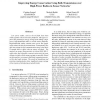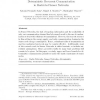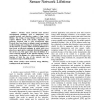207 search results - page 12 / 42 » Random Asynchronous Wakeup Protocol for Sensor Networks |
ICDCS
2008
IEEE
14 years 1 months ago
2008
IEEE
Low power radios, such as the CC2420, have been widely popular with recent sensor platforms. This paper explores the potential for energy savings from adding a highpower, high-ban...
JCO
2006
13 years 7 months ago
2006
We study a novel "coverage by directional sensors" problem with tunable orientations on a set of discrete targets. We propose a Maximum Coverage with Minimum Sensors (MCM...
PUC
2008
13 years 6 months ago
2008
Abstract Wireless sensor networks (WSN) are designed for data gathering and processing, with particular requirements: low hardware complexity, low energy consumption, special traff...
TCS
2012
12 years 2 months ago
2012
In Sensor Networks, the lack of topology information and the availability of only one communication channel has led research work to the use of randomization to deal with collisio...
JNW
2007
13 years 7 months ago
2007
— Wireless sensor networks must measure environmental conditions, such as temperature, over extended periods and therefore require a long system lifetime. The design of long life...



